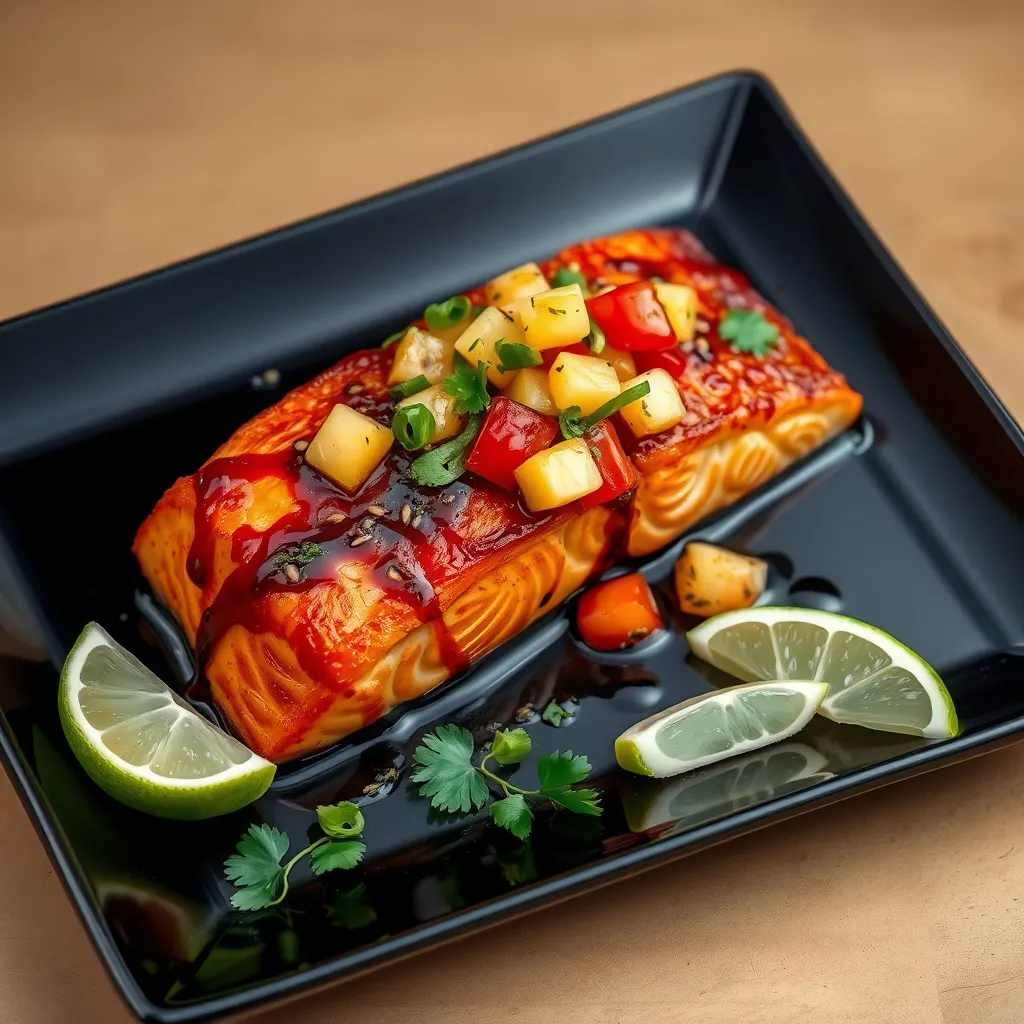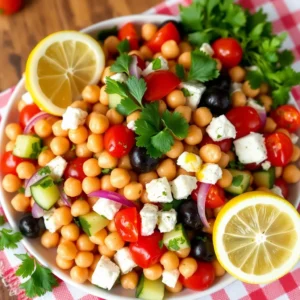Why You’ll Love This Teriyaki Glazed Salmon
Let me tell you something about glazed salmon that might just change your dinner game forever. This Teriyaki Glazed Salmon with Pineapple Salsa isn’t just another fish recipe – it’s the answer to that eternal 5 PM question: “What can I make that’s impressive but won’t have me chained to the stove all evening?”
As a busy parent myself, I understand the dinner dilemma all too well. You want something nutritious (because hello, we’re adults), something that won’t trigger a mealtime meltdown from picky eaters, and something that doesn’t require a culinary degree to execute. This glazed salmon ticks all those boxes and then some!
First off, the entire dish comes together in just 30 minutes – yes, you read that right! In the time it would take to get takeout delivered, you can have a restaurant-worthy meal on the table. Talk about a weeknight wonder! The sweet-savory teriyaki glaze caramelizes beautifully on the salmon, creating a flavor that even fish-hesitant family members find irresistible. It’s my secret weapon for “sneaking” omega-3s into our family meals.
What really sets this recipe apart is the bright, zesty pineapple salsa that tops the glazed salmon. The combination might sound fancy, but it’s surprisingly straightforward to prepare. The tropical sweetness of the pineapple cuts through the rich salmon, creating that perfect balance that makes your taste buds do a happy dance. If you’ve enjoyed my Cilantro Lime Chicken before, you’ll recognize that same bright flavor profile that makes weeknight dinners special without extra fuss.
Beyond the flavor, let’s talk nutrition for a moment. This glazed salmon delivers lean protein, healthy fats, and a rainbow of vitamins from the salsa ingredients. It’s what I call “feel-good food” – delicious enough to satisfy cravings while nourishing your body. As a mom who’s constantly juggling soccer practice carpools and work deadlines, I need meals that fuel my family properly without requiring a second mortgage on specialty ingredients.
The versatility of this teriyaki dinner is another reason you’ll keep coming back to it. Serving unexpected guests? This dish looks impressive enough for company. Meal prepping for a busy week? The leftovers transform beautifully into lunch the next day – just flake the salmon over a salad or tuck it into a wrap with some greens. That’s the kind of kitchen efficiency that makes my heart sing!
The Story Behind This Teriyaki Glazed Salmon
My journey with this Teriyaki Glazed Salmon recipe began, like many good things in my life, through a happy accident. Five years ago, I was planning a dinner party when my carefully orchestrated menu hit a snag – my fishmonger was out of the halibut I’d planned to serve. With guests arriving in hours and a pantry inspection revealing teriyaki sauce and a pineapple that needed using, I took a chance on salmon instead. As they say, necessity is the mother of invention!
What started as a last-minute substitution quickly became a family favorite. My oldest daughter, who typically approached seafood with the enthusiasm of someone being asked to eat homework, took one bite and declared it “actually amazing” – high praise from a then-twelve-year-old whose food pyramid consisted mainly of pasta and chicken nuggets. The recipe has evolved over the years, with each tweak making it a little more foolproof and a little more flavorful.
The pineapple salsa element came later, inspired by a beachside meal during a rare kid-free vacation with my wife. We were sitting at this tiny seafood shack in a coastal town, where they served the most incredible fish tacos topped with a fruit salsa that completely transformed the dish. I spent the rest of the vacation trying to recreate that perfect balance of sweet, spicy, and tangy flavors. By the time we returned home, I knew exactly what my teriyaki salmon had been missing.
What makes this recipe special to me goes beyond its flavors, though. It’s become our “celebration meal” – the dinner I make when report cards come home with good grades, when someone lands a promotion, or when we simply need to turn an ordinary Tuesday into something a bit more special. There’s something about the combination of the caramelized teriyaki glaze and the bright pineapple that feels festive without requiring hours of preparation.
I’ll never forget the time my youngest son helped me prepare this for his grandparents’ anniversary dinner. At eight years old, his dicing skills were, shall we say, creative – those pineapple chunks ranged from barely visible specks to chunks you’d need a steak knife to tackle. But watching him beam with pride as everyone raved about “his” special salsa reminded me that the best recipes aren’t just about perfect execution – they’re about the memories we create around the table.
Over the years, I’ve served this glazed salmon for casual family dinners and special occasions alike. It’s traveled with us to potlucks (where people always ask for the recipe) and beach picnics (where it’s delicious even at room temperature). The beauty of cooking, I’ve found, is how a simple combination of ingredients can become woven into the fabric of your family’s story – each meal a chapter, each shared recipe a connection.
This teriyaki dinner has become more than just food on a plate; it’s become our family’s language of love and celebration. In a world where we’re all constantly rushing from one obligation to the next, these moments around the table – these shared bites of something delicious – become anchors that keep us connected. And isn’t that what good food should do?
Ingredients
Let’s break down everything you’ll need for this glazed salmon masterpiece, with some notes on why each ingredient matters and what you could swap in a pinch. Because let’s face it – sometimes the fridge inventory doesn’t match the recipe requirements, and a little flexibility goes a long way!
For the Teriyaki Glazed Salmon:
- 4 salmon fillets (6 oz each, skin-on) – The star of our show! I prefer wild-caught for better flavor and nutrition, but farm-raised works perfectly fine too. Look for fillets of even thickness to ensure they cook at the same rate.
- ⅓ cup low-sodium soy sauce – Using low-sodium allows you to control the saltiness. If you only have regular soy sauce, reduce the amount to ¼ cup and add a tablespoon of water.
- 3 tablespoons honey – This gives our glaze that perfect sticky consistency and balances the savory soy sauce. Maple syrup or brown sugar can pinch-hit if your honey bear is running dry.
- 2 tablespoons mirin (Japanese sweet rice wine) – This adds authentic flavor and helps tenderize the fish. No mirin? Use 2 tablespoons of white wine with a teaspoon of sugar dissolved in it.
- 1 tablespoon fresh ginger, grated – The zippy warmth of fresh ginger can’t be beat, but in a time crunch, ½ teaspoon of ground ginger will do the trick.
- 2 cloves garlic, minced – The foundation of so many great dishes! If fresh garlic isn’t available, ½ teaspoon of garlic powder can substitute.
- 1 tablespoon rice vinegar – This brightens the sauce. Apple cider vinegar works as a reasonable substitute.
- 1 teaspoon sesame oil – A little goes a long way to add that distinctive nutty flavor. If you don’t have it, you can omit it, but it really does elevate the glaze.
- 1 tablespoon cornstarch + 2 tablespoons water (slurry) – This thickens our sauce into a beautiful glaze. Arrowroot powder works as a 1:1 substitute if you’re avoiding corn products.
For the Pineapple Salsa:
- 1 cup fresh pineapple, diced small – Fresh is ideal for that juicy sweetness, but in winter months when good pineapple is harder to find, well-drained canned pineapple in juice (not syrup) can be your backup.
- ½ red bell pepper, finely diced – Adds a sweet crunch and beautiful color. Any bell pepper works, though red gives the prettiest contrast.
- ¼ cup red onion, finely diced – The sharp bite of red onion gives the salsa character. If it’s too strong for your taste, soak the diced onion in cold water for 10 minutes, then drain and dry.
- 1 jalapeño, seeded and minced (optional) – Adjust to your heat preference or omit entirely if cooking for spice-sensitive folks.
- 3 tablespoons fresh cilantro, chopped – If you’re in the “cilantro tastes like soap” camp, substitute with flat-leaf parsley or mint.
- Juice of 1 lime – The acid that brings everything together. Lemon juice works in a pinch, though lime has that tropical vibe that pairs beautifully with pineapple.
- 1 tablespoon olive oil – Just enough to bring the salsa together.
- ½ teaspoon salt – I prefer kosher salt for its clean flavor.
- ¼ teaspoon black pepper – Freshly ground adds the best flavor punch.
For Serving:
- 2 green onions, thinly sliced – These add a fresh bite and visual appeal.
- 1 teaspoon sesame seeds – For that restaurant-style garnish that makes everyone think you went the extra mile.
- Lime wedges – A final squeeze of fresh citrus right before eating brightens everything up.
- Steamed rice – Not technically part of the recipe, but an absolute must for soaking up that gorgeous glaze! Brown rice adds extra nutrition, or try cauliflower rice for a low-carb option.
What I love about this ingredient list is that while it might look long at first glance, most items are pantry staples that work in countless other recipes. The specialty ingredients like mirin and sesame oil last practically forever in your pantry and will elevate many Asian-inspired dishes, so they’re worth the investment. According to Food Network’s guide on pantry staples, these Asian condiments can transform simple proteins into crave-worthy meals with minimal effort.
Execution
Now that we’ve gathered our ingredients, let’s break down this process step by step. Don’t worry – even if you’re not confident with fish cookery, I’ll walk you through every stage so your teriyaki dinner turns out perfectly.
STEP 1: Prep the Salmon (5 minutes) Begin by taking your salmon fillets out of the refrigerator about 15 minutes before cooking – fish cooks more evenly when it’s not ice-cold. Pat the fillets dry with paper towels (this is crucial for achieving a nice sear!) and season lightly with salt and pepper. Place them on a plate, skin-side down, while you prepare the glaze.
STEP 2: Make the Teriyaki Glaze (7 minutes) In a small saucepan over medium heat, combine the soy sauce, honey, mirin, grated ginger, minced garlic, rice vinegar, and sesame oil. Stir occasionally as the mixture comes to a simmer. Let it bubble gently for about 3 minutes to meld those flavors together.
In a small bowl, whisk together the cornstarch and water until smooth. This is your slurry – the secret to a thick, glossy glaze rather than a thin sauce. Slowly pour this into your simmering teriyaki mixture while whisking constantly. Continue to cook for another 2-3 minutes until the sauce has thickened to the consistency of maple syrup. It should coat the back of a spoon nicely. Remove from heat and set aside.
STEP 3: Cook the Salmon (10 minutes) Heat a large, non-stick skillet over medium-high heat with a tablespoon of neutral oil like canola or vegetable (avoid olive oil here as it has a lower smoke point). When the pan is properly hot – you’ll see a slight shimmer to the oil – carefully place your salmon fillets skin-side down.
Here’s the trick to perfect salmon: resist the urge to move it around! Let it cook undisturbed for about 4-5 minutes until the skin becomes crispy and the salmon has cooked about ⅔ of the way up the sides. You’ll actually see the color change happening.
Gently flip the fillets (a fish spatula is ideal, but any thin spatula works) and cook for just 1-2 minutes on the second side. The center should still be slightly translucent – salmon continues cooking after you remove it from heat, and slightly undercooked is better than overcooked when it comes to this delicate fish.
STEP 4: Glaze the Salmon (3 minutes) Reduce the heat to low and pour about ⅔ of your teriyaki glaze over the salmon fillets, reserving the rest for serving. Gently tilt the pan to distribute the glaze and spoon it over the fillets for about a minute as it bubbles and thickens further. The sugars in the honey will caramelize slightly, creating that beautiful lacquered finish that makes glazed salmon so irresistible.
STEP 5: Make the Pineapple Salsa (while salmon cooks) While your salmon is cooking (or before, if you prefer to have everything prepped), combine the diced pineapple, bell pepper, red onion, jalapeño (if using), cilantro, lime juice, olive oil, salt, and pepper in a medium bowl. Gently toss to combine all ingredients evenly. The longer this sits, the more the flavors meld, so making it slightly ahead of time is perfectly fine. In fact, as renowned chef Bobby Flay explains in his salsa techniques, letting fruit salsas rest for 15-30 minutes allows the salt to draw out juices and develop a more cohesive flavor.
STEP 6: Serve and Garnish (5 minutes) Transfer the glazed salmon to serving plates, either on top of steamed rice or alongside your favorite sides. Top each fillet with a generous spoonful of the pineapple salsa. Drizzle the reserved teriyaki glaze around the plate or directly over the salmon. Sprinkle with sliced green onions and sesame seeds for that professional finishing touch, and serve with lime wedges on the side.
The final visual should be a feast for the eyes: the rich, glossy teriyaki salmon, the vibrant multicolored salsa, the pop of green from the onions, and the subtle crunch of sesame seeds. It’s the kind of meal that makes everyone at the table reach for their phones to snap a picture before diving in – yes, even my teenager who normally inhales food without noticing what it looks like!
If you’ve timed everything right, this entire process takes just about 30 minutes from start to finish. And the best part? Unlike many quick meals, this one looks and tastes like you spent hours in the kitchen. That’s my kind of culinary magic trick!
Additional Tips
Let me share some hard-earned wisdom that will take your Teriyaki Glazed Salmon from great to absolutely magnificent. These are the little tricks I’ve collected over years of making this recipe that make all the difference!
First, let’s talk salmon selection. While any salmon works beautifully in this recipe, if your budget allows, opt for wild-caught Alaskan salmon. It has a richer flavor and firmer texture that stands up wonderfully to glazing. Look for fillets with bright color and a fresh, oceanic smell – never fishy! If your market offers center-cut portions, they’re ideal because their even thickness ensures consistent cooking. Can’t find fresh? Don’t hesitate to use frozen – just thaw overnight in the refrigerator for the best texture.
Temperature matters tremendously when cooking salmon. Beyond bringing it to room temperature before cooking (as mentioned in the execution section), invest in an instant-read thermometer if you’re serious about perfectly cooked fish. For glazed salmon with that melt-in-your-mouth texture, you’re looking for 125°F (52°C) in the thickest part – this gives you medium doneness. Remember, carryover cooking will take it up another 5 degrees after removing from heat.
Make-ahead strategies can be a lifesaver for busy weeknights. The teriyaki glaze keeps beautifully in the refrigerator for up to a week, so consider making a double batch on Sunday for multiple meals. Similarly, the pineapple salsa can be prepared up to 24 hours in advance – though hold the cilantro and lime juice until just before serving to maintain maximum freshness and color.
For a stunning presentation that’s perfect for special occasions, try using a kitchen torch (the type used for crème brûlée) to give the glazed edges extra caramelization right before serving. This creates those beautiful charred spots that restaurant chefs achieve. No torch? Placing the glazed salmon under a broiler for the final 30 seconds works nicely too – just watch it carefully to prevent burning!
Storage and leftovers can be tricky with seafood, but this glazed salmon actually holds up remarkably well. Store leftover salmon and salsa separately in airtight containers for up to two days. I recommend enjoying the salmon cold or at room temperature rather than reheating, which can dry it out. Try flaking the salmon over mixed greens with extra pineapple salsa as dressing for a spectacular next-day lunch.
Dietary adaptations are simple with this flexible recipe. For gluten-free diners, simply substitute tamari for the soy sauce. Need a lower-sugar option? Replace the honey with monk fruit sweetener and use fresh pineapple rather than canned. Watching calories? Reduce the honey to 1 tablespoon and use a bit more ginger and garlic to keep the flavor impact high.
Want to make this a complete meal? Beyond the suggested steamed rice, I love serving this glazed salmon with quick-pickled cucumbers for a refreshing crunch. Simply slice an English cucumber thinly, toss with 2 tablespoons rice vinegar, 1 teaspoon sugar, and a pinch of salt, then let sit while you prepare the rest of the meal. For a more substantial side, steamed broccoli tossed with a little of the reserved teriyaki glaze creates a cohesive meal that feels thoughtfully planned.
If you’re entertaining, consider turning this into a build-your-own salmon bowl bar. Serve the glazed salmon alongside rice, the pineapple salsa, sliced avocado, shredded carrots, edamame, and extra sauce. Guests can customize their bowls according to their preferences, and you’ll look like a culinary genius with minimal extra effort.
Flavor variations keep this recipe exciting even in regular rotation. Try adding a tablespoon of orange zest to the glaze for a citrus twist, or incorporate a teaspoon of Sriracha for gentle heat throughout. The pineapple salsa is equally adaptable – mango makes a delicious substitute for pineapple, and adding diced avocado just before serving adds a creamy element that contrasts beautifully with the glazed salmon.
Finally, don’t discard the salmon skin! When properly crisped during cooking, it’s absolutely delicious – like salmon bacon! If anyone at your table prefers skinless salmon, save those crispy skins as a chef’s treat for yourself. Trust me, they’re too good to waste.
FAQs
Can I make this glazed salmon recipe without mirin? Absolutely! Mirin adds authentic flavor, but it’s not a deal-breaker. The best substitute is 2 tablespoons of dry white wine mixed with 1 teaspoon of sugar. In a pinch, you can even use 2 tablespoons of rice vinegar with 1 tablespoon of sugar, though this will give a slightly different flavor profile. The key is balancing the sweetness and acidity that mirin provides.
How do I know when the salmon is perfectly cooked? The visual cue for perfectly cooked teriyaki salmon is when it changes from translucent to opaque, but still has a slightly darker center when you flake it with a fork. If you’re using a thermometer (highly recommended for beginners), aim for 125°F (52°C) for medium doneness. Remember that salmon continues cooking after you remove it from heat, so it’s better to pull it slightly early than too late. If the white protein (albumin) is seeping out extensively, that’s a sign you’ve overcooked it.
Can I use frozen pineapple for the salsa? Yes, frozen pineapple can work in the salsa, but with some adjustments. Thaw it completely first, then drain thoroughly and pat dry with paper towels to remove excess moisture. The texture won’t be identical to fresh – it tends to be softer – but the flavor remains delicious. For the best results with frozen pineapple, add an extra squeeze of lime juice and a pinch more salt to brighten the flavors.
Is this teriyaki dinner recipe suitable for meal prep? This glazed salmon recipe is surprisingly meal-prep friendly! Cook the salmon as directed but slightly undercook it (about 1 minute less than specified). Store the cooked salmon, glaze, and salsa in separate containers. When ready to eat, drizzle the salmon with a little glaze and gently warm it in the microwave for just 30 seconds – this prevents the dry, overcooked texture that reheated fish can sometimes have. Add the fresh salsa after reheating for a meal that tastes nearly identical to freshly prepared.
My family doesn’t like spicy food. How should I adjust the pineapple salsa? The beauty of homemade salsa is complete control over the heat level! Simply omit the jalapeño entirely for a mild version that’s kid-friendly. The salsa will still be flavorful from the pineapple, bell pepper, onion, cilantro, and lime. If you want just a hint of warmth without noticeable spice, try using just a quarter of a jalapeño with all seeds and membranes removed, as that’s where most of the heat resides.
Can I grill this salmon instead of cooking it in a pan? Grilling adds a wonderful smoky dimension to this glazed salmon! Prepare a medium-hot grill (around 375-400°F) and oil the grates well. Place the salmon skin-side down and close the lid. Cook for 4-6 minutes until the skin crisps and releases easily from the grate. Brush with teriyaki glaze, carefully flip, brush the skin side with glaze, and cook for just 1-2 more minutes. Continue basting with glaze as it cooks. For easier handling, consider using a cedar plank, which also imparts amazing flavor. As grilling expert Steven Raichlen notes, “The key to grilling fish is what I call the 70/30 rule: Cook it 70 percent of the way on the first side until the skin is crisp and releases easily, then flip and cook 30 percent on the second side.”
I don’t have fresh ginger. Can I substitute ground ginger? Yes, though the flavor won’t be quite as vibrant. Substitute ½ teaspoon of ground ginger for the 1 tablespoon of fresh in the glaze. If you regularly cook Asian-inspired recipes, consider keeping a knob of ginger in your freezer – it grates easily while frozen and lasts for months, ensuring you always have fresh ginger on hand for recipes like this teriyaki dinner.
This glazed salmon recipe has become a cornerstone in my kitchen repertoire because it strikes that perfect balance between impressive and achievable. The caramelized teriyaki coating creates a flavor-packed exterior while keeping the salmon moist and tender, and the bright pineapple salsa adds a tropical freshness that makes every bite exciting. Whether you’re cooking for a special occasion or simply elevating a weeknight dinner, this teriyaki glazed salmon delivers restaurant-quality results with home kitchen simplicity.



